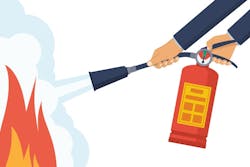A good friend of mine owns a shop in a rural part of New York. We became friends through our mutual affiliation with various organizations. Throughout the years, he has complained about business more times than I can count, blaming everything from his employees, the government, the weather and, of course, the economy. Then one day, at a conference, he asked me if I would visit his shop for a day to see if I could point out things that could help his business. At first, I said no. But after an hour of begging and the promise of a steak dinner, I agreed.
A month later, I decided to visit him. It was a hot summer day and I arrived at his shop around 11 a.m. There was no one in the office, so I walked into the shop and asked, “Is Tony here?” (not his real name). A tech popped out from under the hood and pointed up to the ceiling. I looked up and the tech said, “No, walk outside and look up.” I walked outside, looked up and there he was, repairing the roof. He was covered in tar and sweat and looked like hell. I yelled up to him, “Tony, I’m here for my visit and I’m all done. You owe me a steak dinner. What’s wrong with your business has nothing to do with the world around you. What’s wrong with your business is you.”
We decided on lunch, not dinner. I had a burger, not a steak. Tony was upset over what I said and told me that he can’t afford to pay someone to fix the roof. I asked him to tell me what he does during the day. He replied, “I am everywhere. I have to watch over everything and everyone. I check the cars out in the morning, sell the jobs, do the book work, road test the cars, and check the jobs after they’re done. I bill out customers at the end of the day, do more paperwork, make a few phone calls and then go home.” I replied, “And you’re also the shop’s handyman?” Tony frowned and said, “That’s not fair, Joe.”
I did feel bad after I said that, but it needed to be said. Tony’s condition is a classic example of running a business from crisis to crisis, also known as putting out fires all day long. Tony is so entrenched with the day-to-day operations that it’s impossible for him to work on the business.
The fires that occur each day are real, and need to be dealt with. But here’s the reality about crisis management: The more fires you put out, the more the fires increase. Working on the business is where Tony needs to be. The results may not immediate, but the more you work on the business, and on things that pay off in the future, the less fires there will be to put out.
Highly successful people know precisely what they should be doing. But more importantly, they know what they should not be doing. That’s not to say you should ignore a crisis. Things do happen that need your immediate attention. But, being involved in every situation and every decision will only lead to spreading yourself too thin, and, eventually, lead to a decline in business.
If you feel you are in crisis management mode, write down all that you do in a day. How many of the tasks you perform actually build for the future and how many are actually putting out daily fires? Set aside time each day, even if it’s only 30 minutes to start with, to work on the things that will pay off in the future. For example, if your labor sales are low, then set aside time to review all your invoices to find ways to cure those labor issues. Or, perhaps it’s the schedule that’s a mess and not balanced with the right mix of service and repair work.
Learn to delegate, too. Empower your employees to help find ways to improve business. You will find that your best employees are up to the challenge. In fact, they will become more engaged when they know you have trust in them and include them in on the daily operations.
The key thing to remember is that you cannot run your business by running from crisis to crisis. Understand your role as the owner. Saying no to something that you should not be doing is perhaps the best decision you can make. Peter Drucker, known as the founder of modern management, said, “There is nothing so useless as doing efficiently that which should not be done at all.”
About the Author

Joe Marconi
Joe Marconi has more than four decades of experience in the automotive repair industry. He is the owner of Osceola Garage in Baldwin Place, N.Y., a business development coach for Elite Worldwide, and co-founder of autoshopowner.com.
